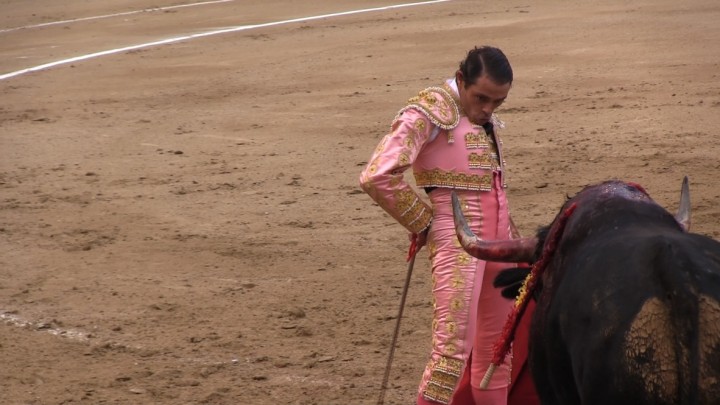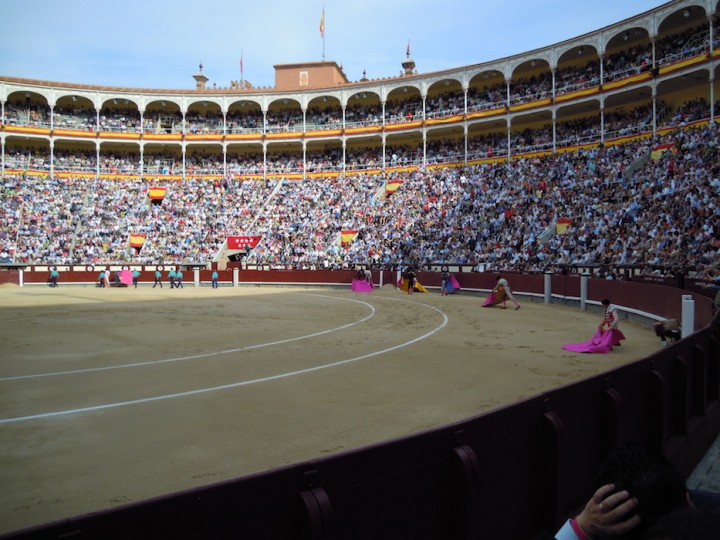Una de las partes ceremoniales más bellas y emocionantes de una Corrida de toros es lo que en el argot taurino se conoce como “Paseíllo”
Al principio de una corrida de toros, todos sus participantes recorren caminando, a menudo escuchando las notas de un Paso Doble interpretado en vivo por los músicos en la Plaza, el trayecto entre la Puerta de Cuadrillas y el burladero situado bajo el Palco presidencial. A esta especie de desfile de presentación se le da el nombre de Paseíllo.
La posición de cada persona en el Paseíllo obedece a reglas muy precisas establecidas por una tradición secular.
En primera posición aparecen los dos Alguacilillos a caballo, que previamente han recorrido el ruedo recordando su antigua función de despejar la plaza, es decir, de asegurarse de que en el ruedo está vacío y listo para que comience la lidia.
Inmediatamente detrás se sitúan los tres matadores ubicados de izquierda a derecha según su antigüedad. El matador más antiguo se sitúa a la izquierda, el siguiente en antigüedad a la derecha y el más joven en el centro.
Detrás de los matadores aparecen los 9 banderilleros (tres por matador), también posicionados según su antigüedad. A continuación salen los seis Picadores ( dos por Matador) ordenados en dos filas. Detrás aparecen 8 Monosabios o asistentes del Picador, 8 areneros encargados del mantenimiento del ruedo , 6 Muleros y dos tiros de Mulas que remolcarán al toro muerto. Una vez que los matadores han saludado respetuosamente al Presidente se sitúan tras el burladero a esperar la salida del toro y dar comienzo al primer tercio de la lidia.

Archivo por meses: marzo 2017
Origen y Función de La Montera
La Montera es la prenda con la que los toreros se cubren la cabeza durante los dos primeros tercios de la corrida. Antes de coger la muleta y empezar a torear con ella, el torero brinda el toro a alguien lanzándole la montera. A veces la lanza al ruedo para brindar el toro al público. La montera fue usada por primera vez por Francisco Montes ( Paquiro) en 1835. Una interesante teoría acerca de los orígenes de la montera es aquella según la cual èsta tenía una doble función: En primer lugar, la de ser una especie de peluca que destacara una cierto aspecto femenino del torero; y , en segundo lugar, tenía la función de disfraz para que el torero se asemejase a su bestial adversario. Actualmente las moteras están hechas de astracán, pero antiguamente se hacían de piel de cordero negro. Al hacer el Paseíllo los toreros parecen una manada de reses que se mueven de un modo organizado.
The Montera is the element with which the bullfighters cover their heads during the first two thirds of the bullfight. Just before taking the cape and starting the fight, the bullfighter gives the Montera to the person to whom he wants to offer the bull’s death. If he offers it to the public he will throw the Montera to the arena, usually backwards, and if there is no offering he will be picked up by one of his assistants.
The Montera was introduced by Francisco Montes (Paquiro) around 1835.
An interesting theory about the origin of the Montera is that it had a double essential function: Firstly, to emphasize the feminine aspects of the bullfighter in the first part of his fight. Therefore the Montera would be a sort of wig to highlight the femininity and delicacy of the human fighter. And secondly, it was a kind of disguise by which the bullfighter identifies himself with the bull. Nowadays the Monteras are usually made of astrakhan, but they were formerly made of black lambskin. At the time of the opening of the gate, the bullfighters seem to be an emerging human cattle and, when they walk in the arena during the opening procession ( El Paseillo) they look like a herd.

The “Suerte De Matar”
The “Suerte de Matar” consists of preparing the bull for its death and of
killing it by the use of the sword. The amount of time it takes to execute the bull’s death is limited and is indicated by warning signals given by the presidency. The most important of these signals are directed to the matador who, through lack of experience, uses an excessive amount of time to consummate the death of the bull. The correct thrusting of the sword is one that penetrates to the butt of the sword. If it doesn´t penetrate enough, it is called “Pinchazo”.
Once the bull is dead, the audience, by applause and whistles,
judges the matador´s performance and, as such, influences the
final ruling from the president.
Two ears and tail .This is the highest trophy awarded in bullfighting in the
category of first class. The president must take out the white
kerchief three times before the bull is dragged away.
Two ears
The trophies that ensure that the bullfighter will be carried on
the public´s shoulders through the main door of the bullring.
The president must take out the white kerchief three times
before the bull is dragged away.
One ear
The audience decides if the bullfighter deserves the prize. The
president must grant the bull´s ear to the bullfighter if the
majority of the audience shows their white kerchief.
Greeting
This is the consolation prize given, when despite the
bullfighter´s best efforts, things don´t come out the way he
had intends.
Tribute To Manolo Montoliu in Valencia
Manolo Montoliu (1954-1992) was an spanish Bullfighter and Banderillero. He was born in Valencia and killed by the bull Cabatisto in Sevilla. In the year 2017 will be held in Valencia several tributes to this great Matador.
But what is a Banderillero? What are Banderillas?
One of the things that most impresses those who attend a bullfight for the first time is the stage of banderillas ( Tercio de Banderillas). It is brief, since it usually does not last more than five minutes, but very intense, because the man faces the bull without the protection of the cape or the muleta. It can also become an aesthetic experience, if the banderillero does his job well and the bull charges fiercely. However, it is not easy to understand its meaning and sense within the framework of the entire bullfight.
The main objective of the Stage of “Banderillas” is to prepare the bull for the next stage: The Stage of Muleta (Suerte de Muleta). The Stage of Varas is the phase in which the bull is lanced by the Picador in order to weaken it and prepare it for the Stage of Muleta (Suerte de Muleta). After being lanced the bull has lost its initial impetuosity , lowering its head and charging only just when it is provoked by the Matador. And now its aggressiveness must be a little bit awakened in order to equilibrate its strenght and be prepared to the stage of Muleta. The bull feels a sharp pain when the “Banderillas” have pierced its back and it Seems to regain his strength and fierceness
Three bullfighters’ assistants or sometimes the bullfighter him or herself jab the bull’s back with three pairs of “Banderillas”. The bull feels a sharp pain when the “Banderillas” have pierced its back.
In the chapter X of “Death In The Afternoon”, Hemingway wrote about the Stage of “Banderillas”, Providing very interesting data to better understand this important part of the Bullfight.
“Act two is that of the banderillas. These are pairs of sticks about a yard long, seventy centimetres to be exact, with a harpoon-shaped steel point four centimetres long at one end. They are supposed to be placed, two at a time, in the humped muscle at the top of the bull’s neck as he charges the man who holds them. They are designed to complete the work of slowing up the bull and regulating the carriage of his head which has been begun by the picadors: so that his attack will be slower, but surer and better directed. Four pair of banderillas are usually put in. If they are placed by the banderilleros or peones they must be placed, above all other considerations, quickly and in the proper position. If the matador himself places them he may indulge in a preparation which is usually accompanied by music. This is the most picturesque part of the bullfight and the part most spectators care for the most when first seeing fights. The mission of the banderilleros is not only to force the bull by hooking to tire his neck muscles and carry his head lower but also, by placing them at one side or another, to correct a tendency to hook to that side. The entire act of the banderillas should not take more than five minutes. If it is prolonged the bull becomes discomposed and the fight loses the tempo it must keep, and if the bull is an uncertain and dangerous one he has too many opportunities to see and charge men unarmed with any lure, and so develops a tendency to search for the man, the bundle, as the Spanish call him, behind the cloth when the matador comes out for the last act with the sword and muleta.”

What is the Feria de San Isidro?
The Feria de San Isidro consists of a series of bullfights that are held in the Bullring Las Ventas in Madrid every year between May and June. It was initially called Feria de Madrid. But later the word Madrid was replaced by San Isidro in honor to the patron saint of Madrid. Over the years the Feria de San isidro became the first and most important Bullfighting event in the word. It was created by Livinio Stuyck, when he was in charge of Las Ventas Bullring in 1947. At the time the Feria cosisted only of 5 bullfights, but currently the number of bullfights is nearly 31.
La Feria de San Isidro es una serie de festejos taurinos que se celebran en la Monumental de las Ventas de Madrid, entre mayo y junio, en torno a la festividad de San Isidro Labrador (15 de mayo), el santo patrono de la capital española. Inicialmente denominada Feria de Madrid, con el tiempo se ha convertido en una de las ferias taurinas más prestigiosas del mundo.
Fue creada en 1947 por el empresario Livino Stuyck quien, al hacerse cargo de la gerencia del coso madrileño, decidió reunir en un solo abono continuo, coincidiendo con la festividad de San Isidro, todas las corridas que se celebraban en mayo. En un principio la feria la formaban solo cinco corridas, que luego fueron subiendo a diez y a quince hasta llegar a los 28 festejos actuales, que se celebran diariamente durante un mes entero: 24 corridas de toros, 2 novilladas y 2 de rejones.

